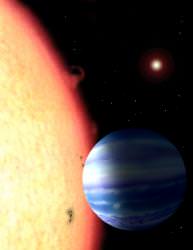Of the extrasolar planets astronomers have discovered, it’s the hot jupiters that really boggle the imagination. These worlds can be much larger than Jupiter, but tear around their parent star in just a few hours. Or in the case of newly discovered TrES-3, in just 31 hours.
This latest discovery, titled TrES-3: A Nearby, Massive, Transiting Hot Jupiter in a 31-Hour Orbit, will be published in an upcoming issue of the Astrophysical Journal Letters.
As with many planetary discoveries, this was a team effort, made by astronomers and observatories around the world. The story begins when astronomers measured a periodic dimming around parent star GSC 03089-00929 – a G-dwarf star 90% the mass of the Sun. Since the discovering instruments were part of the Trans-atlantic Exoplanet Survey (TrES) network, this is how the planet got its name.
Once the astronomers had a candidate, other astronomers performed follow up observatories using the Hungarian Automated Telescope Network, the Fred L. Whipple Observatory, the Submillimeter Array atop Mauna Kea, and a handful of other instruments around the world. By the time they were done, hundreds of observations had been made in many wavelengths.
It’s currently estimated to have a mass of approximately 1.92 the mass of Jupiter. As mentioned, it orbits its parent star once every 31 hours – at a distance of only 0.0226 AU (1 AU = the distance from the Earth to the Sun). That sounds fast, and it is. The current record is OGLE-TR-56b, which orbits every 29 hours. So TrES-3 comes in a close second.
Based on their observations, TrES-3 is not a grazing transit. In other words, the planet passes directly between the star and the Earth, fitting its disk entirely within the disk of the star at mid-transit. The transit itself takes only 1.3 hours to complete. This provides astronomers with a useful testbed for theoretical models of gas giants. Astronomers want to understand what happens to planets this close to their parent star; how their orbits decay, and rate of thermal evaporation from being so close.
And here’s the mystery. At this close distance to its star, TrES-3 must be going furious evaporation of its gas. Astronomers are wondering if a planet could form this close, and still be around billions of years later. Another possibility is that it formed further out, and was pulled in close over millions of years. TrES-3 is so close that its gravity tidally effects the star, modifying the rate at which its orbit decays, and confusing the calculations.
The astronomers are planning follow up observations of TrES-3 with the powerful Spitzer Space Telescope, since it’s an ideal candidate for attempts to detect reflected starlight. This will allow astronomers to measure the planet’s albedo, or reflectiveness.
Original Source: Arxiv Release
Thanks to Dr. Pamela Gay for helping me puzzle through some of the scientific language.

